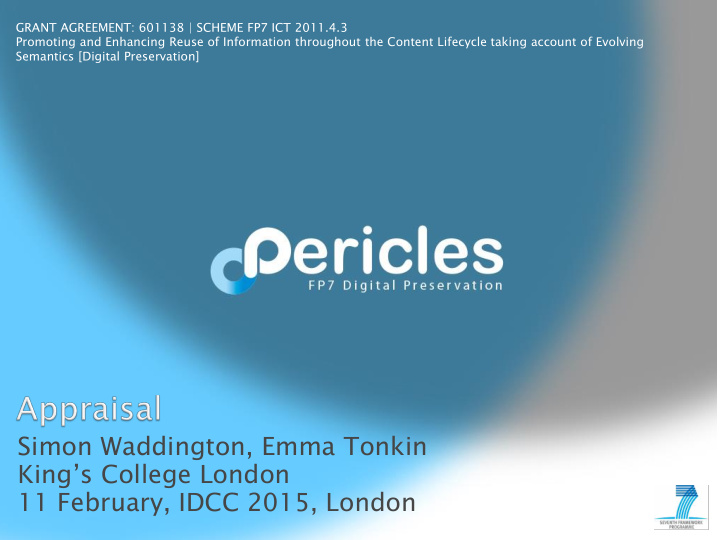



GRANT AGREEMENT: 601138 | SCHEME FP7 ICT 2011.4.3 Promoting and Enhancing Reuse of Information throughout the Content Lifecycle taking account of Evolving Semantics [Digital Preservation] Simon Waddington, Emma Tonkin King’s College London 11 February, IDCC 2015, London
PERICLES appraisal task Background on appraisal Case studies Breakout session
Runs for 22 months from November 2014 Objectives ◦ Identification and modelling of key decision factors e.g. authenticity, unique information content, technical feasibility ◦ Modelling of decision processes ◦ (Partial) automation or computer-assisted guidance What can be automated and what should be? ◦ Monitoring evolution of the interests of user communities
Appraisal ◦ Identify digital objects of continuing business value “Value” may include ◦ Historical, aesthetic, scientific, financial, social judgements ◦ Relevance to a community ◦ Frequency of use, reuse, creation of derived works Further factors ◦ Increasing size and complexity of content ◦ How faithful a representation is it of what was originally ◦ intended? ◦ Technical feasibility ◦ Relationship to other items in collection
Hard to define criteria precisely ◦ Often relies on human judgement Result depends on context of appraisal ◦ e.g. time, appraiser, organisation, current trends (e.g. artistic tastes, research), user communities, technologies ◦ These are subject to change Manual appraisal is costly ◦ (Manual) item-level appraisal impractical for large collections Risks ◦ Bias – when looking at content in future, need to know under what assumptions it has been selected (chain of evidence) ◦ Potential that valuable content can be lost
“Traditionally”, appraisal is carried out at or beyond end of active life Post-custodial models ◦ Not based on physical custody of non-current records by an archival authority ◦ Digital content is continuously evolving over time ◦ No concept of “end of life” ◦ Preservation occurs “in the wild” Appraisal performed at multiple points in lifecycle – including at creation
Top-down approaches ◦ Legal compliance ◦ Policy and organisational objectives ◦ Functional/macro appraisal – based on business function Bottom-up approaches ◦ Item-level appraisal Extraction of metadata from content and environment ◦ Inventory
Space science data originating from the ESA and ISS For example ◦ Experiments that monitor the sun's spectral variability to understand its effects on climate (SOLAR) Includes ◦ Science data – calibrated observations ◦ Operations – raw data, telemetry, logs, documentation ◦ Engineering documentation Durations ◦ Missions – last decades ◦ Experiments – 1-10 years
Payload Issues engineer ◦ Changing science Engineering data communities Space ◦ Complex agencies Reuse (e.g. Shared dependencies Scientists NASA, ESA (different knowledge domain) ◦ Cross-domain Science Operations ◦ Volume of data data data ◦ Erroneous Scientists (same experiments Creation domain) Mission and Operator ◦ Different reuse perspectives of SOLAR stakeholders on what scientist is valuable ◦ Staff turnover
Main objectives • Traditionally • Active use ◦ Identify items of end of use + mandate ongoing historical fo r LTDP Collected Video value Born- production digita l ◦ Maintain capability archives to display items in an authentic manner Software- Digital (e.g. in line with based art video art • Active use • Active use + mandate + mandate artist intent) Video production for LTDP for LTDP
Issues ◦ Fragility of content ◦ Usability ◦ Ephemeral nature ◦ Subjectivity ◦ Determining audience and context Appraisal supports acquisition and retention decisions ◦ Often made at a senior level
Group discussion and analysis of appraisal in specific examples relevant to PERICLES We make use of motivating scenarios to establish compete etency ncy questi estions ons ◦ Using these, we are able to explore the consequences of appraisal processes Participants are welcome to contribute their own relevant experience and problems
Gain understanding of ◦ Where is there value in performing appraisal? ◦ What criteria should be applied? ◦ Which appraisal approaches are most appropriate? ◦ Where is there value in (partial) automation and what are the technical enablers? ◦ When in the lifecycle should we appraise? ◦ How can we account for changing user communities and their interests?
Within groups, choose between the space science and video art use cases. 1. Study the use case, and consider the appraisal criteria provided on the attached sheet. a. What do you consider to be the main reasons for performing appraisal in this use case? b. What appraisal criteria are the most relevant for this use case and why? Do you think that the criteria provided in the attached sheet are sufficient? c. Do you need further information about the object itself (or its surrounding infrastructure) to make these appraisal decisions? d. When in the lifecycle should we appraise against these criteria? e. What aspects of appraisal using these criteria could/should be automated and what are the enablers? f. How can we account for changing user communities and their interests? 2. Select one or more scenarios from the examples provided. a. What does this scenario tell you about the appropriate appraisal practices in this context? b. Does successful completion of this scenario depend on expert knowledge or information, and if so, how much of the relevant expert knowledge is currently captured?
Recommend
More recommend